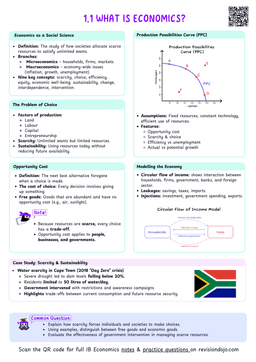Taxes
Mandatory payments made by households and firms, collected by governments.
- Poverty, income and wealth inequalities are one of the most pressing issues in contemporary economics.
- In order to deal with these issues, governments often need to intervene.
- One of the most common ways for governments intervention to reduce poverty and income and wealth inequalities is through taxation.
Remember that there are two main forms of government taxes:
- Direct taxes: paid directly to the government by individuals or organisations.
- Indirect taxes: applied to goods and services, paid indirectly by consumers through the price of goods, including:
- Taxes on spending.
- Excise taxes.
- Custom duties.
Direct taxes
Direct tax
Tax paid to the government directly by the taxpayer (individual).
There are three main types of direct taxes:
- Personal income taxes: taxes levied on an individual's income from factors of production (rent, wages, interests, profits).
- Corporate income taxes: taxes imposed on a company's profits after deducting expenses and allowances.
- Wealth taxes: taxes on the market value of an individual's assets, such as property, investments, and savings.
People often confuse the income tax on investment earnings (such as interest or dividends) with wealth taxes on the value of the investments themselves. While income tax applies to the returns generated from investments, wealth taxes are levied on the total market value of the assets owned.
Progressive, regressive and proportional taxes
Taxes can be differentiated by the following characteristics:
- Progressive taxes:
- The higher the income, the higher the proportion of income paid as tax will be.
- For example:
- If you make less that USD 50,000 a year, you pay 10% of income tax.
- If you make between USD 50,000 and USD 100,000 a year, you pay 20% of income tax.
- If you make more than USD 100,000, you pay 50% income tax.
- Regressive taxes:
- As income increases, the proportion of income paid as tax lowers.
- For example:
- If you make less that USD 50,000 a year, you pay 50% of income tax.
- If you make between USD 50,000 and USD 100,000 a year, you pay 20% of income tax.
- If you make more than USD 100,000, you pay 10% income tax.
- Proportional taxes:
- As income increases, the proportion of income paid as tax will stay constant.
- For example:
- If you make less that USD 50,000 a year, you pay 20% of income tax.
- If you make between USD 50,000 and USD 100,000 a year, you pay 20% of income tax.
- If you make more than USD 100,000, you pay 20% income tax.
The table below illustrates the three different tax systems, two income levels, and the amount of tax paid at each tax system.
| Income 1($) | Income 2($) | Percentage of Tax Paid on Income 1 | Amount of Tax Paid for Income 1 in $ | Percentage of Tax Paid on Income 2 | Amount of Tax Paid for Income 2 in $ | |
|---|---|---|---|---|---|---|
| Proportional | 20000 | 50000 | 10% | 2000$ | 10% | 5000$ |
| Progressive | 20000 | 50000 | 10% | 2000$ | 20% | 10000$ |
| Regressive | 20000 | 50000 | 10% | 2000$ | 5% | 2500$ |
Progressive taxes are often chosen by governments to address income inequalities. This is because of their redistributive effects:
- Those in low-incomes pay little taxes, increasing their disposable income to increase their human capital and wealth.
- Contrarily, those in high-incomes pay a lot of taxes, which governments can use to support those in low-incomes through benefits such as direct payments, financing education...
- Hence, through a progressive tax system, the government redistributes income and wealth from the rich to the poor, making it a key tool in addressing poverty and inequalities.
On the other hand, proportional taxes are often praised for their simplicity but criticised for not addressing poverty and inequalities. While some consider them to be more equitable, other argue that it is more equitable to have progressive taxes to counteract the advantages to building income and wealth that high-income earners have over low-income earners.
Indirect taxes
Indirect taxes
Taxes imposed on goods and services, paid to the government by sellers but ultimately borne by consumers.
- Indirect taxes are levied on goods and services rather than on income or wealth.
- Even though producers transfer indirect taxes to the government, they are typically paid by consumers through higher prices.
- Common types include value-added tax (VAT), excise duties on specific goods (e.g., alcohol, tobacco), and customs duties on imported goods.
The regressive nature of indirect taxes
Common MistakeIt is a very common mistake to believe that indirect taxes are a form of proportional taxes.
- Indirect taxes are fixed, at a certain rate (20%, USD 2 per kg...) for a certain product.
- As a result, to acquire that good, consumers with lower incomes have to pay a higher proportion of their income in indirect tax than consumers with higher incomes.
- Therefore, indirect taxes are regressive, and worsen income distribution.
While indirect taxes can disproportionately affect lower-income groups, they are often used to fund essential public services.


